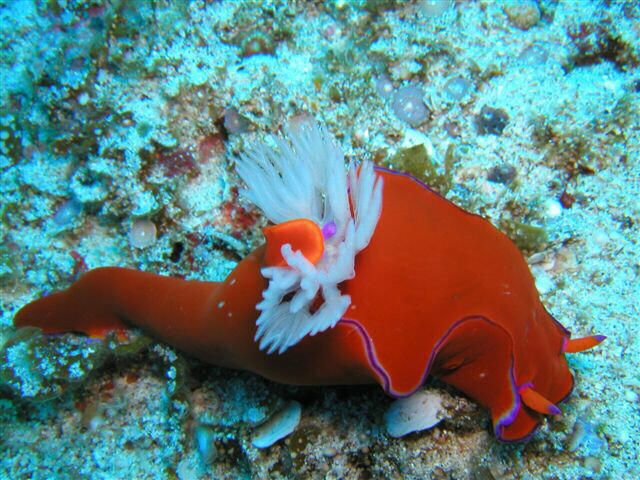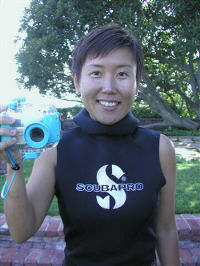 |
Ceratosoma trilobatum
Photo taken by Hiroko ShimadaChiChiJima Island, Japan
May, 2002
Ceratosoma trilobatum (J.E. Gray, 1827)
Every couple of weeks webmaster Miller throws a challenge at me. This week is just another one of those weeks. What's a guy supposed to do? When I first saw this photo, I nearly fell out of my cush, black leather, ergonomic office chair. Who was Mike trying to kid? What in the hay was this? Had the photographer gone nuts in PhotoShop? Not the case.
It has long been realized that the Ceratosoma's and Ceratosoma trilobatum in particular, were highly variable in color, even to the extreme where species begin to overlap each other in appearance. This specimen, however, sets a new extreme for Ceratosoma trilobatum. Bill Rudman distinguishes C. trilobatum from its closest sibling, Ceratosoma tenue by having only one large lateral lobe on each side of the body, and a ridge joining each lateral lobe to the anterior head lobe (C. tenue has two lobes on each side of the body, and the ridge disappears between the lobes). He also points out that the purple line along the edge of the mantle is most often continuous, as seen in the photo above. From here on out Hiroko's specimen, breaks all the rules. I have never seen a specimen quite as flamboyantly colored as this one. The uniform, bright red body and sparkling white gills are way outside the established color range documented to date for this creature. Wow!
Hiroko's specimen was shot this May in the Ogasawara Islands of Japan. These islands are extremely remote and can only be reached by a 25 hour ferry boat ride. The islands are about 500 south of Tokyo. This gorgeous nudibranch was found in 15 meters of water at ChiChiJima , the largest of the two inhabited islands, in the Ogasawara chain.
Ceratosoma trilobatum's name denotes the "three lobes" on the dorsum. The Sea Slug Forum shows several examples of how large and colorful the dorsal lobe or horn can be. This lobe contains a gland filled with nasty chemicals to discourage predators from chowing down on these beauties. The chemicals are derived from materials in the sponge on which Ceratosoma feeds. The bright warning (or aposomatic) colors of this species provide an easy to remember image for a fish that has just gotten a mouthful of distasteful chemicals and wants to remember who not to bite again.
Danville, Calif
Jul., 2002

All photos were taken with an Olympus digital camera--Model C40-zoom with an Olympus plastic housing -Model #012, using onboard flash. This tiny housing is rated to 40 meters. These photos represent her first attempts at macro photography with a digital camera. She has been diving in a number of locations in Japan including the Izu Penninsula, Okinawa, the Kerama islands, and Kushimoto. During her May trip to Ogasawara, she observed appoximately 15 different species of nudibranchs.
You can drop Hiroko a note at 1hiroko@san.rr.com |
Webmaster's Notes: Not bad for a first time attempt at Nudibranch Photography, would you agree folks? Once again, I feel like Rip Van Winkle who has just awoke to the wonders of the digital photography age! Hiroko's amazing digital photography doesn't end with nudibranchs! She also has a shot of a hammerhead taken on a recent trip to the Bahamas that is a potential show stopper! Buying a digital camera for underwater applications is like trying to hit a moving target the technology is changing so fast. We will endeavor in future presentations to relate personal experiences and images of photographers who are taking a giant leap forward and getting wet with digital photography.
Webmaster
San Diego, CA
